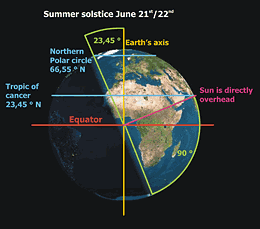
The summer solstice occurs exactly when the Earth’s axial tilt is most inclined towards the sun at its maximum of 23° 26′. Though the summer solstice is an instant in time, the term is also colloquially used like Midsummer to refer to the day on which it occurs. Except in the polar regions (where daylight is continuous for many months during the spring and summer), the day on which the summer solstice occurs is the day of the year with the longest period of daylight.

Thus the seasonal significance of the Summer solstice is in the reversal of the gradual shortening of nights and lengthening of days. The summer solstice occurs in June in the Northern Hemisphere and in December in the Southern Hemisphere.

North of the Tropic of Cancer (23°26′N) and south of the Tropic of Capricorn (23°26′S), the Sun reaches its highest position in the sky on the day of the summer solstice. However, between the Tropic of Cancer and the Tropic of Capricorn, the highest sun position does not occur at the summer solstice, since the sun reaches the zenith here and it does so at different times of the year depending on the latitude of the observer. Depending on the shift of the calendar, the summer solstice occurs some time between December 21 and December 22 each year in the Southern Hemisphere, and between June 20 and June 21 in theNorthern Hemisphere.

Worldwide, interpretation of the event has varied from culture to culture, but most cultures have held a recognition of sign of the fertility, involving holidays, festivals, gatherings, rituals or other celebrations around that time.
The word solstice derives from Latin sol (sun) and sistere (to stand still).

